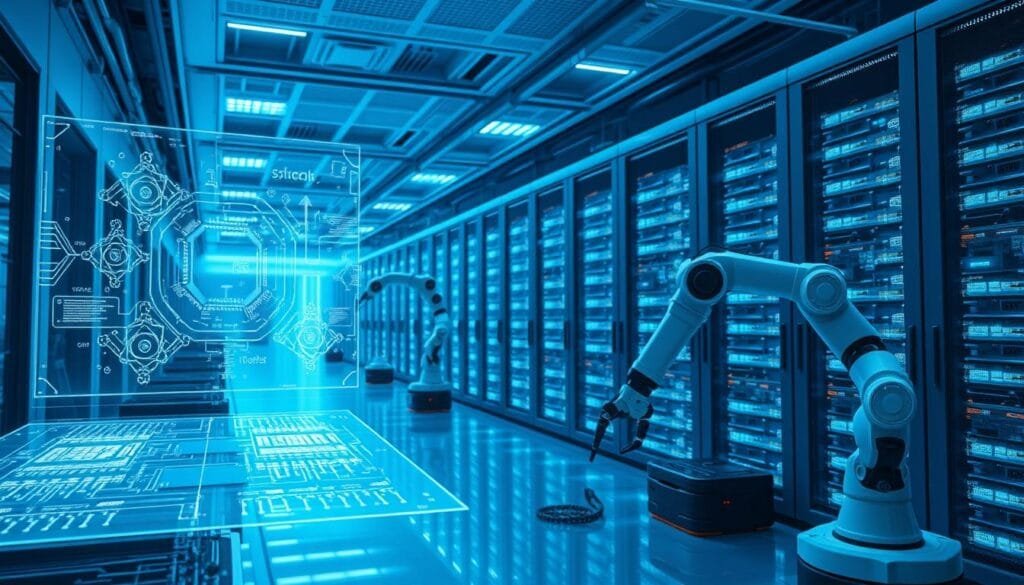Are you ready to explore the future of AI? Artificial intelligence is reshaping how we live, work, and make decisions. Generative AI models such as ChatGPT and similar systems from major research labs have accelerated this change by making sophisticated content generation and conversational interfaces widely accessible. Behind those applications are advances in data-driven modeling and scalable training methods that are already influencing business processes, public services, and everyday tools.
AI’s reach now extends from large-scale data analysis and scientific research to consumer-facing assistants and household automation. That breadth — from backend systems that optimize supply chains to front-line tools that help people accomplish routine tasks — is why the future of AI matters to leaders, workers, and citizens alike.
AI is not only improving efficiency and safety in workplaces; it is actively reshaping the future of work by changing which tasks people perform and how organizations use systems and data to make decisions. This article walks through the current state of the technology, likely near- and mid-term developments, the implications for industries and workers, and practical steps organizations and individuals can take to prepare.

Key Takeaways
- Artificial intelligence is being applied across domains — from enterprise systems to consumer services — and its scope is growing.
- Generative AI tools are driving prominent, visible change, but their impact depends on the underlying data and models that power them.
- The effect on employment will be mixed: automation will displace some tasks while creating new roles that require different skills.
- Understanding current AI trends, data needs, and likely use cases is essential for preparing organizations and people for the future.
- When thoughtfully adopted, AI can enhance workplace efficiency and safety; when rushed, it risks amplifying bias, increasing risk, and producing brittle systems.
The Current State of AI Technology
Recent breakthroughs in artificial intelligence have expanded practical possibilities across industries. At the core of that progress are machine learning advancements — larger models, better training techniques, and richer datasets — that enable systems to recognize patterns, interpret language, and make predictions at scale. Those technical building blocks are turning research prototypes into deployable systems for business and public use.
Recent Breakthroughs in AI Development
The pace of development has accelerated in several technical domains that matter for commercial adoption and product design:
- Improved natural language processing — models can generate coherent text, summarize documents, and support conversational agents with growing reliability.
- Enhanced computer vision — systems now interpret images and video for tasks such as quality control, medical-image analysis, and automated inspection.
- Advancements in deep learning — innovations in architectures and training (including transfer learning and contrastive methods) have increased model capability while lowering the cost per task.
Notable Research Achievements
High-profile research milestones and open-source releases have pushed capabilities forward and accelerated adoption. Breakthroughs in model scaling, multimodal learning, and efficient training routines have improved real-world performance and enabled new types of applications. Those research gains translate into more capable models and more dependable systems for production environments.
Commercial Applications Gaining Traction
As models become more robust, businesses are moving from experimentation to production. Concrete use cases include predictive maintenance for industrial equipment, automated document processing for back-office operations, and conversational AI that augments customer support teams rather than fully replacing them. These applications demonstrate how AI can reduce cost, accelerate decision-making, and surface new insights from data.
Key Players Driving AI Innovation
AI innovation today is driven by a mix of large companies that fund long-term research and startups that focus on narrow, deployable solutions. This combination accelerates both foundational advances and practical, industry-specific tools.
Tech Giants’ AI Initiatives
Major technology firms continue to invest heavily in AI research and productization, sponsoring fundamental work in areas such as reinforcement learning, large language models, and systems for efficient model deployment. Those investments help move breakthroughs from lab to production-scale systems used in enterprise settings.
Promising AI Startups to Watch
Startups specializing in data labeling, model optimization, and industry-specific applications are important sources of innovation and commercialization. Companies that streamline access to high-quality data and simplify model integration shorten the path from proof-of-concept to business value.

Overall, AI technology is maturing: improved models and richer data pipelines are enabling systems that integrate into enterprise technology stacks. For businesses, the immediate question is not whether to experiment with AI, but how to align AI systems with reliable data, clear objectives, and governance practices so those systems deliver measurable value.
The Future of AI: Predictions and Possibilities
Forecasts for the future of AI point to continued rapid evolution that will reshape industries, organizational processes, and the roles people perform. Recent market and analyst reports suggest meaningful adoption across enterprises, and while specific percentages vary by source, the trend is clear: investment and deployment are accelerating as models and data infrastructure mature.
Expert Forecasts for AI Capabilities
Credible research organizations and consulting firms expect a mix of incremental and step-change improvements over the next decade. Rather than a single breakthrough, observers anticipate steady advances in model capability, systems integration, and the human processes that surround AI deployment.
Short-term Developments (1-3 Years)
Over the next one to three years, businesses should expect broader, more reliable applications of existing technologies. Practical short-term developments include:
- Improved natural language processing — better summarization, faster document understanding, and more context-aware conversational agents that reduce routine workloads.
- Enhanced predictive analytics — models that combine operational data and external signals to forecast demand, maintenance needs, or risk with greater precision.
- More sophisticated AI-powered chatbots — hybrid human-AI workflows where bots handle triage and routine inquiries while humans take complex cases.
Long-term Projections (5-10 Years)
Looking five to ten years ahead, expect AI systems to participate more directly in decisions that were once the sole remit of people — not by replacing judgment, but by augmenting it with rapid pattern recognition across vast datasets. Anticipated long-term shifts include:
- Advanced machine learning models — models that are multimodal, more sample-efficient, and better at transfer learning across domains.
- AI in decision-making — systems that provide evidence-backed recommendations across clinical, financial, and operational contexts while exposing confidence and limitations.
- Breakthroughs in AI research — progress in robustness, interpretability, and safety that enable higher-stakes deployments.
Emerging AI Research Directions
Researchers are focusing on directions that address both capability and trust: explainable AI to surface why models make particular predictions, edge AI to bring intelligence closer to sensors and devices, and multimodal learning that fuses text, vision, and other signals. These lines of work aim to expand opportunities while reducing risks associated with opaque or brittle systems.
Cutting-edge AI Technology Innovations
Explainable AI will make model outputs more interpretable for users and regulators; edge AI will reduce latency and improve privacy by keeping processing near data sources. Both innovations have practical implications for deployment across industry cases — from near real-time anomaly detection on factory floors to on-device assistants that process user data locally.
These developments will have material effects on work: some routine tasks will be automated, others augmented, and new roles will emerge that center on data curation, model oversight, and system integration. For organizations, the immediate imperative is to pilot responsibly, align projects to measurable outcomes, and invest in the people and processes needed to capture opportunities.

| AI Development StageKey FeaturesPotential Impact | ||
| Short-term (1-3 years) | Improved NLP, predictive analytics, AI chatbots | Enhanced business productivity, efficiency |
| Long-term (5-10 years) | Advanced ML models, AI in decision-making, AI in research | Complex problem-solving, new scientific breakthroughs |
AI’s Transformative Impact on the American Workforce
The American workforce is entering a period of substantial change driven by artificial intelligence. Rather than a uniform displacement, the effect varies by occupation, region, and industry: some roles will be automated, others will be augmented, and entirely new jobs will emerge that center on data, model oversight, and system integration. Understanding these patterns helps businesses, workers, and policymakers plan pragmatic responses.
Current Employment Statistics and Trends
Recent labor-market analyses show uneven impacts: routine, task-based work is most exposed to automation risk, while occupations requiring complex judgment, creativity, or interpersonal skills tend to be more resilient or experience role changes. At the same time, many employers report increased demand for workers with data and machine skills to deploy and maintain AI systems.
Sectors Already Experiencing AI Disruption
Industries such as manufacturing, customer service, and transportation are already integrating AI at scale. In manufacturing, automated inspection and predictive maintenance reduce downtime and shift human roles toward supervision and maintenance of automated systems. In customer-facing businesses, conversational systems and automation handle routine inquiries, enabling human agents to focus on higher-value or escalated cases. In transportation, the development of autonomous vehicles and route-optimization systems is changing logistics and fleet management functions.
Geographic Distribution of AI-Related Job Changes
The local impact of AI varies with industry concentration and the regional labor mix. Regions with high manufacturing density or large technology sectors tend to show earlier and deeper shifts in job tasks and training needs. That geographic variation creates both risks and opportunities for local economies and calls for targeted workforce development strategies rather than one-size-fits-all solutions.
Case Studies: Companies Implementing AI Solutions
Several large organizations provide instructive examples of business-led AI adoption. IBM has deployed AI-driven customer service platforms and enterprise analytics that augment human agents and improve response times; Amazon uses advanced machine learning across logistics, from demand forecasting to warehouse automation, enabling faster fulfillment and lower operational costs. These implementations commonly increase efficiency and create new technical and managerial roles, while also changing the skill mix required for frontline staff.
For business leaders, the practical takeaway is clear: conduct an AI impact audit on core processes, identify high-value pilots that combine measurable KPIs and workforce transition plans, and invest in reskilling for affected workers. For workers, prioritize transferable skills tied to data, critical thinking, and human-centered problem solving to remain competitive as industries evolve.
Jobs at Risk: Identifying Vulnerable Employment Sectors
Artificial intelligence is reshaping labor demand by automating specific tasks rather than entire occupations in most cases. Estimates vary by methodology, but multiple studies indicate a substantial share of jobs will require new skills by the late 2020s; those changes tend to concentrate in roles with high volumes of repetitive, routine work and limited need for complex social judgment.
Automation Vulnerability Assessment by Industry
Risk depends on the task composition of each role and on how organizations deploy AI. Jobs that involve predictable, codifiable tasks are more susceptible to automation, while roles requiring creativity, complex problem-solving, or deep interpersonal interaction are less likely to be fully automated and more likely to be augmented.
High-Risk Occupations
Occupations that emphasize repetitive processing of data or standardized interactions show higher exposure. Common examples include:
- Data entry clerks — where structured inputs and outputs make automation straightforward
- Telemarketing and telesales — which rely on scripted interactions that can be handled by voice bots and automated outreach
- Manufacturing line workers — especially for repetitive assembly and inspection tasks that vision systems and robots can perform
Factors Determining Automation Potential
Several criteria influence whether tasks are automatable:
- Degree of human interaction required — high-touch roles are harder to automate
- Task complexity — routine, rule-based tasks are easier to codify
- Decision criticality and the need for contextual judgment — safety-critical or highly contextual decisions often resist full automation
Real-World Examples of AI Replacing Human Tasks
AI is already replacing or reshaping discrete tasks across industries: chatbots and automated phone systems handle first-level customer inquiries, machine learning pipelines process large volumes of data for reporting, and vision systems perform quality-control inspection on production lines. These task-level shifts typically reduce labor time and cost per operation but also create demand for workers who can manage, validate, and improve the underlying systems.
| IndustryAutomation Risk LevelExamples of Automated Tasks | ||
| Manufacturing | High | Assembly line work, quality control |
| Customer Service | Medium | Chatbots, automated phone systems, first-level triage |
| Data Analysis | High (for routine processing) | Data processing, automated report generation, initial anomaly detection |
New Opportunities: Jobs Created by AI Industry Developments
As artificial intelligence matures, it is creating new roles across industries as much as it is automating routine tasks. AI continues to transform industries by shifting work from repetitive execution to higher-value activities such as model design, data stewardship, and systems integration — roles that draw on technical skills but also domain knowledge and human judgment.
Emerging Job Categories in the AI Ecosystem
The AI ecosystem now supports a broad mix of positions spanning technical, operational, and governance responsibilities. These roles appear across industries from healthcare to finance and logistics, reflecting demand for people who can turn models and data into reliable business outcomes.
Technical Roles in AI Development
Technical openings remain plentiful. Common roles include AI engineers, machine learning specialists, and data scientists who build, validate, and deploy models. Typical hiring signals are proficiency with data pipelines, experience training models on real-world datasets, and familiarity with model evaluation and monitoring in production. For many markets, starting salary ranges for entry-level positions are competitive and rise quickly with domain expertise and demonstrable project experience.
Non-Technical Positions Supporting AI Implementation
Non-technical roles are increasingly important for safe, scalable AI adoption. AI project managers coordinate cross-functional delivery; AI ethicists and policy specialists help define governance frameworks; and AI trainers or data annotators ensure high-quality labeled data for supervised learning. Organizations that invest in these roles reduce deployment risk and accelerate the path from pilot to production.
Skills in High Demand for the AI Economy
Workers who combine technical literacy with transferable domain skills will be most competitive. High-demand capabilities include data literacy (understanding data provenance and quality), model literacy (knowing what models can and cannot do), critical thinking, creativity, and complex problem-solving. For domain specialists — clinicians, financial analysts, supply-chain managers — the shortest pathway is often acquiring applied data skills and learning to collaborate with technical teams.
Practical pathways into AI roles vary: a data analyst can move toward an ML engineer role by learning model-building and MLOps practices; a product manager can become an AI product lead by gaining hands-on experience with prototypes and performance metrics. For employers, building internal career ladders that combine domain expertise with AI training reduces hiring friction and strengthens competitive advantage.
Adaptation Strategies: Preparing for an AI-Driven Workplace
AI development is accelerating, and organizations that treat learning as strategic infrastructure will be best positioned to capture benefits while managing risk. Preparing for an AI-driven workplace requires coordinated action by workers, employers, educational institutions, and public agencies: targeted reskilling, clear career pathways, and changes in organizational processes so people and systems work together effectively.
Reskilling and Upskilling Approaches
Reskilling and upskilling should be pragmatic and prioritized by near-term business value. That means focusing first on the skills that enable employees to collaborate with AI systems and to validate outputs: data literacy, basic model understanding, experiment design, and domain-specific problem solving. Soft skills — communication, empathy, and complex judgment — remain essential because many high-value tasks require human oversight and stakeholder engagement.
Corporate Training Initiatives
Leading companies are combining internal training, apprenticeships, and partnerships with academic providers to move at scale. Programs that tie training to measured business outcomes (reduced error rates, faster throughput, higher customer satisfaction) are most effective. For example, corporate reskilling efforts typically include:
- Identifying skill gaps through capability audits and aligning training to high-impact workflows
- Creating modular learning paths (micro-credentials, bootcamps) focused on data handling, model evaluation, and tool use
- Implementing mentorship, rotational assignments, and on-the-job coaching to embed new skills
When practical, companies should publish transparent metrics (completion rates, role transitions, ROI) so programs can be iterated and scaled across the organization.
Self-Directed Learning Resources
Individuals can supplement employer programs with self-directed learning. Online platforms such as Coursera and edX offer targeted courses and professional certificates in data skills, AI fundamentals, and ethics. Short, project-based learning — where learners produce a portfolio artifact tied to a business case — accelerates employability more than passive coursework.
Educational Programs Focused on AI Competencies
Colleges and universities are updating curricula to combine technical instruction with ethics and applied problem solving. That means not only teaching algorithms and data engineering but also how to integrate models responsibly into real-world processes. Partnerships between industry and academia help ensure course content maps to employer needs.
Academic Degrees and Certifications
Formal degrees and certificate programs remain important signals in the labor market. Top graduate programs and professional certificates teach both foundational theory and hands-on systems work; for many learners, shorter professional certificates or bootcamps provide faster paths into entry-level AI-support roles. Employers should consider recognizing a mix of credentials — academic degrees, vendor certifications, and demonstrable project experience — when hiring.
Practical 90-day plan for workers: (1) Audit your role to identify data- or AI-adjacent tasks; (2) Complete one targeted short course (data literacy or model basics); (3) Build a small project or case study to demonstrate applied skills and share it with your manager. Organizations: start with a pilot training tied to an operational KPI, measure results, and scale the program where it produces measurable value.
Machine Learning Advancements Changing How We Work
The future of work is being reshaped by machine learning: better models, larger datasets, and more efficient training pipelines are turning experimental systems into practical tools that improve productivity and decision-making. These advances matter because they enable organizations to extract actionable insights from data, automate routine processes, and reallocate people to higher-value activities.
AI-Powered Productivity Tools
AI-powered productivity tools now appear across knowledge work and operations. Examples include automated forecasting that reduces planning cycles, intelligent document processing that extracts structured data from unstructured content, and scheduling assistants that free people from administrative overhead. When evaluated correctly, these tools deliver measurable efficiency gains — lower processing time, fewer errors, and faster time-to-decision.
To assess a productivity tool, use practical KPIs such as time saved per task, error-rate reduction, cost per transaction, and user satisfaction; pilot programs should track these metrics before scaling.
Industry-Specific Applications
Different industries are capturing value in specific ways. In finance, models analyze large datasets to improve risk analysis and detect fraud more quickly; in healthcare, models assist clinicians by highlighting likely diagnoses from images or patient records and helping personalize treatment plans. In each case, the quality of the underlying data and the integration of models into clinical or operational workflows determine real-world impact.
Human-AI Collaboration Models
Successful deployments emphasize collaboration rather than replacement: AI systems handle repetitive or data-intensive subtasks while people provide oversight, interpret nuanced outcomes, and make final decisions. Hybrid workflows — for instance, AI triage followed by human review — often yield the best balance of efficiency and safety.
Successful Implementation Examples
Across manufacturing and services, pilots show tangible benefits: AI-assisted inspection reduces defect rates and rework; conversational systems handle routine customer inquiries and shorten response times, while human agents resolve complex cases. These are not theoretical gains — they translate into measurable improvements in throughput, cost per case, and customer satisfaction when projects are managed with clear objectives and quality data.
Estimates of macroeconomic impact vary with assumptions, but the consistent finding is that well-governed machine learning applications can generate significant gains for businesses and people by increasing efficiency, lowering costs, and enabling new services. The practical challenge for leaders is to align model deployment with data quality, governance, and change management so those gains are realized sustainably.
Deep Learning Applications Across Employment Sectors
Deep learning — a set of machine learning techniques that use layered neural networks — is increasingly applied across industries to automate routine tasks, surface insights from complex data, and improve the quality of professional services. Its value comes from the ability to learn representations from large datasets and apply those patterns to prediction, classification, and generation tasks that were previously impractical at scale.
Industry-Specific AI Use Cases
Deep learning is being used across multiple sectors with concrete, measurable applications:
- Healthcare and medical diagnostics — assisting clinicians by flagging abnormalities in medical images and prioritizing cases for review.
- Financial services and risk assessment — detecting fraud, scoring credit risk, and spotting unusual patterns across transaction streams.
- Education and personalized learning — tailoring content and assessments to individual learners based on performance signals.
Healthcare and Medical Diagnostics
In healthcare, deep learning systems are typically deployed as decision-support tools rather than autonomous diagnosticians. For example, convolutional neural networks can help highlight suspicious findings on X-rays and MRIs for radiologist review. Regulatory approval and clinical validation are essential: many applications are evaluated in peer-reviewed studies or cleared by regulators before routine clinical use, and success depends heavily on data quality, representative training sets, and integration into clinical workflows.
Financial Services and Risk Assessment
Financial firms use deep learning models to analyze large, heterogeneous datasets for fraud detection, anti-money-laundering alerts, and risk modeling. These systems can surface subtle signals that would be difficult for human analysts to spot at scale, but they require robust monitoring to avoid concept drift and to ensure explainability when decisions affect customers.
Impact on Professional Service Delivery
Across professional services, deep learning automates repetitive parts of the process (data extraction, initial triage, routine forecasting) while leaving complex judgments to human experts. That shift allows professionals to focus on tasks that require domain expertise, client interaction, and ethical judgment. Adoption barriers — such as data privacy regulations, model interpretability, and integration costs — remain important considerations for organizations planning deployments.
Policy Responses to AI-Driven Employment Shifts
Policymakers are scrambling to match the pace of artificial intelligence development with regulation and workforce supports. The policy challenge is twofold: reduce the risks that misapplied systems pose to people and markets, while preserving incentives for innovation that create new opportunities and business value. Effective responses blend regulation, retraining programs, and targeted social supports.
Current Legislative and Regulatory Initiatives
At the federal level, administrations and agencies have begun publishing guiding frameworks and proposals to address AI-related harms and governance gaps. For context, the U.S. government released an AI safety and governance blueprint in recent years that emphasizes civil rights protections, data privacy, and transparency; international counterparts — notably the EU’s AI Act — offer useful comparisons in scope and regulatory approach. These initiatives signal growing appetite for regulation that clarifies acceptable use without unnecessarily stifling innovation.
Federal Approaches to AI Governance
Federal strategies typically combine guidance documents, agency rulemaking, and cross-agency coordination to address AI use in high-risk contexts. Policy levers include standards for model transparency and testing, sector-specific rules (for healthcare, finance, and transportation), and incentives for responsible data practices. The goal is to balance protection of workers and consumers with pathways for organizations to deploy systems responsibly.
State-Level Policy Innovations
States are experimenting with their own regulatory and procurement approaches, from privacy rules to guidelines on algorithmic decision-making in government services. These state-level innovations can serve as testbeds, producing practical lessons for national policies and offering different regulatory models for local industries and labor markets.
Proposed Solutions for Worker Protection
Policy proposals to address labor-market disruption include direct income supports, expanded retraining subsidies, wage insurance, and public–private reskilling partnerships. Each option has trade-offs in cost, political feasibility, and the speed at which it can be deployed.
Universal Basic Income and Alternative Models
Proposals such as universal basic income (UBI) are often debated as long-term safety nets; proponents argue UBI could cushion transitions, while critics point to high fiscal cost and uncertain labor-market effects. More targeted alternatives — wage insurance for displaced workers, portable benefits, or subsidized training tied to employer demand — may provide more politically feasible and fiscally focused ways to support transitions at scale.
“The future of work is not just about technology; it’s about people. We need policies that support workers through this transition.”
Practical next steps for policymakers and organizations include piloting public–private retraining programs, funding impact evaluations of proposed supports, and establishing regulatory sandboxes that allow innovators to test systems under oversight. For regulators, the immediate priorities are clear: set standards for data and model governance, require transparency where decisions affect people materially, and pair regulation with investments in education and worker supports so the gains from AI are broadly shared.
Navigating the Future: Balancing AI Progress and Human Potential
Artificial intelligence trends are reshaping economies, institutions, and everyday life. The future of AI presents substantial opportunities — from new business models to productivity gains — but it also raises clear social, ethical, and economic challenges that require deliberate management.
Achieving a constructive balance means three practical priorities: aligning AI development with human values, investing in people so they can access new opportunities, and creating governance that mitigates risks while preserving innovation. That balance will determine whether AI amplifies the power of organizations and people or concentrates benefits in ways that leave many behind.
For different audiences, the implications are concrete:
Business leaders should audit AI-readiness across systems and data, prioritize pilots tied to measurable outcomes, and commit to workforce transition plans; workers should map which job tasks are most exposed and pursue targeted learning in data literacy and problem-solving; policymakers should pair proportionate regulation with investments in retraining and safety nets to spread the gains.
In short: treat AI as a strategic tool, not an inevitability. Start with small, measurable steps — assess data quality, run a limited pilot, and create a 90-day re-skilling plan — and scale what demonstrably benefits both organizations and people. That approach gives the best chance of turning the future of AI into broadly shared opportunity rather than uneven disruption.
FAQ
What is the current state of AI technology?
How will AI impact the American workforce?
What are the most vulnerable employment sectors to AI-driven automation?
What new job opportunities are created by AI industry developments?
How can workers prepare for an AI-driven workplace?
What is the role of machine learning advancements in changing the way we work?
How are deep learning applications being used across various employment sectors?
What policy responses are being proposed to address AI-driven employment shifts?
How can we balance AI progress with human potential?
What are the future AI capabilities and research directions?
67 Funny Christmas Ornament – 67 Meme Teen Slang Santa Says Six Seven Acrylic Ornament, Rizz Gyatt Skibidi Delulu Sus Holiday Decor, Viral Xmas Gift for Gen Z Teens
$10.99 (as of 04:04 GMT -05:00 - More infoProduct prices and availability are accurate as of the date/time indicated and are subject to change. Any price and availability information displayed on [relevant Amazon Site(s), as applicable] at the time of purchase will apply to the purchase of this product.)Boolegon No Drill No Tools Cellular Shades Top Down Bottom Up Honeycomb Blinds Blackout Cordless Window Blinds Easy to Install Cellular Shade for Windows,Blackout-White,Custom Size
$39.00 (as of 04:04 GMT -05:00 - More infoProduct prices and availability are accurate as of the date/time indicated and are subject to change. Any price and availability information displayed on [relevant Amazon Site(s), as applicable] at the time of purchase will apply to the purchase of this product.)NICETOWN 100% Blackout Window Curtain Panels, Cold and Full Light Blocking Drapes with Black Liner for Nursery, 84 inches Drop Thermal Insulated Draperies (White, 2 Pieces, 52 Wide Each Panel)
$26.99 (as of 04:04 GMT -05:00 - More infoProduct prices and availability are accurate as of the date/time indicated and are subject to change. Any price and availability information displayed on [relevant Amazon Site(s), as applicable] at the time of purchase will apply to the purchase of this product.)DEZ FURNISHINGS Cordless 2" Faux Wood Blind, 46" W x 48" H, White
Now retrieving the price.
(as of 04:04 GMT -05:00 - More infoProduct prices and availability are accurate as of the date/time indicated and are subject to change. Any price and availability information displayed on [relevant Amazon Site(s), as applicable] at the time of purchase will apply to the purchase of this product.)







